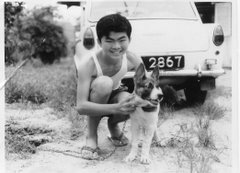Christmas is just around
the corner. And if you are pondering over what to get for someone who, like me,
is from the baby-boomer generation, why not get him a copy of my book, Good
Morning Yesterday. So far, many of my friends who have read the book have
thoroughly enjoyed the trip down memory.
My book should be
available at Popular, Times and Kinokuniya (best to call first). It was last
seen on the shelves at the following outlets:
- Popular @ Clementi Mall
(Tel: 6514-6710)
- Popular @ Toa Payoh (Tel:
6358-1700)
- Popular @ United Square
(Tel: 6478-2318)
- Kinokuniya @ Ngee Ann
City (Tel: 6737-5021)
- Times @ Centrepoint (Tel:
6734-9022)
- Times @ Plaza Singapura
(Tel: 6336-8861)
- Times @ Tampines (Tel:
6782-7017)
Besides these book
stores, you can also purchase them at Haf Box and Betel Box. Haf Box deals
mainly with lifestyle products for what they call “active agers”. Betel Box, on
the other hand, runs a hostel and Bistro in Joo Chiat Road and also conducts
heritage tours. Their details are as follows:
HAF Box Pte Ltd
19 Tanglin Road #03-32 Tanglin
Shopping Centre, Singapore 247909
Tel: 6235-4560
Betel Box Hostel, Bistro & Tours in
Singapore
200 Joo Chiat Road, #01-01, Singapore 427471.
Tel: 6247-7340
www.betelbox.com
.jpg) |
| Thanks to Catherine Ling for this photo. |
Incidentally, the
restaurant at Betel Box serves great Peranakan food in a traditional
Singaporean ambience. They even have a special corner where you can browse and
purchase Singapore heritage-related merchandise like books, dvds and heritage
items.
Recently a group of us, heritage and food bloggers, were hosted to a Peranakan lunch by Betel Box’s boss, Tony Tan. Although I am not much of a ‘foodie’ – whenever I go to a food court or hawker centre, I just go for the stall with the shortest queue – I could tell that the Peranakan cuisine here was very good …. at least my fellow bloggers thought so. We were served dishes like botol kacang, ikan sumbat, ngo hiang, hae cho, asam pedas red snapper, nonya yong tau hu and laksa goreng. My favourites were the botol kacang (salad), ikan sumbat and laksa goreng.
.JPG) |
| With Tony Tan. Behind us are display shelves of heritage merchandise, including Good Morning Yesterday the book. |
.JPG) |
| Tony giving an introduction to his business and their food |
.JPG) |
| Notice that only Philip Chew and I not taking any photos of the food. We were waiting for the young people to finish their obligatory shots before we could sink our teeth into this delicious salad call Botol Kacang. |
.jpg) |
| Can you guess where this shot was taken? That's me in the toilet mirror. Photo courtesy of Juria T |
Back to my book. If you
have difficulty getting it from the above places, or if you want to get several
copies, you can contact me directly at: cslam@hoshin.com.sg and we will work something out.
Have a blessed Christmas.
Information on Popular’s
outlets and locations here.
Information on Times’
outlets and location here.
.jpg)
.JPG)
.JPG)
.jpg)
.JPG)
+(13).JPG)
1.jpg)

+(4).JPG)




.JPG)
.JPG)
.JPG)
.jpg) When I last visited the National Library at Victoria Street, I saw some exhibits of the old library cards. I am trying to recall the system for borrowing and returning books. Hope older readers can confirm if I remember correctly.
When I last visited the National Library at Victoria Street, I saw some exhibits of the old library cards. I am trying to recall the system for borrowing and returning books. Hope older readers can confirm if I remember correctly.
 Below is a map of from my 1981 street directory for reference.
Below is a map of from my 1981 street directory for reference. "If my memory serves me, it used to be a sort of make-shift, single storey open coffee shop; i.e. without walls. Stalls may be a better word. So as the bus rounded the bend from Armenian Street and turns left into Stamford Rd, immediately there is bus stop. This coffee shop is directly behind the bus stop. Immediately after the bus stop is the entrance (for cars) to the Nat Lib. Further down is the exit, and after that is the National Museum.
"If my memory serves me, it used to be a sort of make-shift, single storey open coffee shop; i.e. without walls. Stalls may be a better word. So as the bus rounded the bend from Armenian Street and turns left into Stamford Rd, immediately there is bus stop. This coffee shop is directly behind the bus stop. Immediately after the bus stop is the entrance (for cars) to the Nat Lib. Further down is the exit, and after that is the National Museum.







